Tamper Proof Security System / Burglar Alarm Wiring
Information on Normally Closed vs. Normally Open circuits and
EOLR (Single End Of Line Resistor) & DEOLR (Double End Of Line Resistors)
Normally Open vs. Normally Closed
While no wiring can be completely tamper proof, there are a couple of things you can do to make disabling your alarm system more difficult. These methods may not be enough to protect a business like a jewelry store, but they are more than adequate to protect your home from a common thief.
The first thing to do is to use normally closed (NC) circuits when possible. Most alarms and sensors by default are configured this way. To understand why you should first understand how a common window sensor works. An open circuit is a broken, interrupted, or incomplete circuit. For alarm systems, a normally open (NO) circuit is in the open state when the alarm has not been tripped. Closing the circuit sets off the alarm. A closed circuit is a connected and complete circuit. A normally closed circuit is closed when the alarm is not active. opening a normally closed circuit sets off the alarm.
The circuit below is an over simplified example of a Normally Open alarm circuit. When the switch is open under normal conditions the circuit is incomplete and the siren will not sound. When the switch is closed then the circuit becomes complete. The connection from the battery to the siren is complete and this activates the siren.
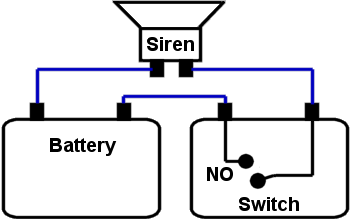
Window sensors are the best way to show a real alarm circuit in action. A window sensor consists of 2 parts. The first is a magnet that is attached to the part of the window that moves. The second part has the wire connections and should be mounted to the frame around the window or to the part of the window that doesn't move. When the window is closed, the two parts of the sensor should be right next to each other.
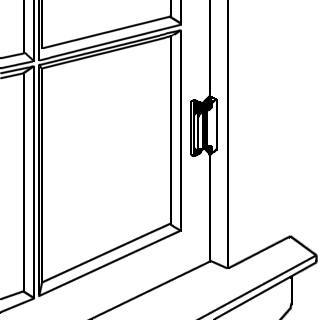
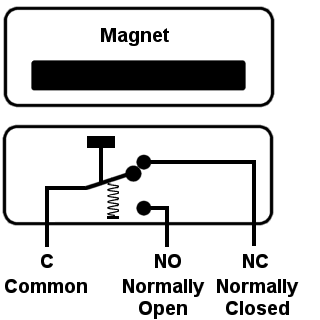
The wired part of the sensor contains a switch that can connect to two different contacts. When the magnet is near this switch, the magnet will attract the switch toward the normally closed contact. When the magnet is removed (because the window has been opened), the spring pulls the switch toward the normally open contact. You will connect the common contact and either the Normally Closed (NC) or Normally Open (NO) contact to your alarm system.
When using the normally open (NO) contact, the connection between the common (C) and NO contacts is broken when the window is closed. When the window is open the magnet is removed and the spring pulls the switch toward the Normally Open contact which closes the circuit and activates the alarm.
One of the drawbacks with Normally Open circuits is that cutting the wire will deactivate the window sensor. With a Normally Closed circuit, cutting the wire will set off the alarm. With a Normally Closed circuit, opening the circuit will activate the alarm and opening the window or cutting the wire has the same effect.
Single and Double End Of Line ResistorsAdding resistors to the sensor circuit path allows the alarm panel to determine more than if the circuit is simply open or closed. It can be used to differentiate between an active alarm, alarm tampering by cutting a wire, and a short in a wire. Note that End Of Line Resistors (EOLRs) can only be used if the alarm panel has been designed to use them. Consult your alarm manual before using any resistors. The diagrams below and resistance values may not apply to your alarm panel.
Single End Of Line Resistors (EOLR) are common with monitored alarms so that the monitoring company can differentiate between a cut wire and a tripped sensor. Some installers will place the resistor in the alarm panel but this not correct. The resistor should be placed at the sensor to better detect cut wires.

In an alarm system without resistors, a thief can bypass a sensor by cutting the wire on a normally open circuit, or by shorting the wires in a normally closed circuit. Using normally closed circuits with properly placed resistors makes it harder to bypass the sensor.
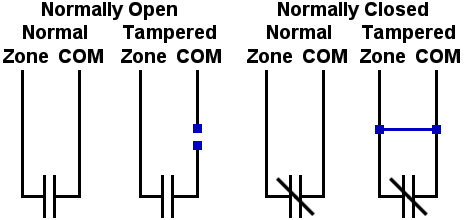
Below are diagrams indicating where to place Single End Of Line Resistors. The Normally Open and Normally Closed items in the diagrams represent the sensor and how it was wired.
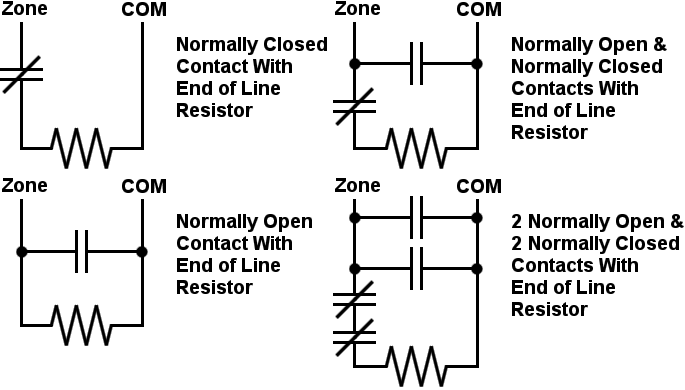
Note: These diagrams show a simplistic version of wiring a sensor. Typically, 2 conductor wire is used to wire window/door sensors and 4 conductor wire is used on motion or glass sensors. It is not a simple loop of single conductor wire as shown above. See our page on Wiring the Sensors to see how to run the wires and what colors to use.
Tables below assume 5600Ω resistors are used. See Resistor Color Codes for more info.
| Resistance | Normally Open Meaning | Normally Closed Meaning |
|---|---|---|
| 0Ω | Zone violated. Sensor tripped - Alarm Activated | Zone fault. Wire shorted - Alarm Activated |
| 5600Ω | Zone secure. | Zone secure. |
| Infinite Ω | Zone fault. Wire shorted - Alarm Activated | Zone violated. Sensor tripped - Alarm Activated |
Double End Of Line Resistors (DEOLR) can also indicate if a wire has been cut. DEOLR only works with one Normally Closed sensor per zone. Do not use DEOLR for fire, supervisory and keypad based zones. For this to work properly, both resistors should be with the sensor - not in the alarm panel. Otherwise, tampering with the sensor by shorting it as shown above will successfully bypass the sensor. See alarm wiring for examples.
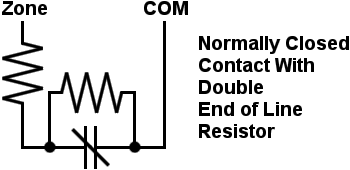
| Resistance | Meaning |
|---|---|
| 0Ω | Zone fault. Wire shorted - Alarm Activated |
| 5600Ω | Zone secure. |
| 11200Ω | Zone violated. Sensor tripped - Alarm Activated |
| Infinite Ω | Zone tampered with. Wire cut - Alarm Activated |
The last security measures to take are with the alarm panel itself. If an intruder is able to get to the alarm panel and disable it before the siren goes off or before it alerts the monitoring company, then the alarm is useless. Remember that opening a door doesn't automatically set off the alarm. By default you will have 30 seconds to enter the code to deactivate the alarm before the siren sounds. An intruder will also have 30 seconds to find and disable the alarm.
Purchase a lock for the alarm panel box if it did not come with one. Keep the alarm panel locked at all times. Do not store the keys on or near the alarm panel.
All alarm systems have a battery backup, but the battery might not be included with your system. Get the backup battery and keep the battery locked in the alarm box.
The alarm panel should not be visible through any windows (including small basement windows). It should not be placed near any entrance to the home. For example, don't place the panel in the mud room - the room off of the garage entrance. The room containing the alarm panel should be protected by sensors, or if there are no windows to that room, then the adjacent room could also be protected preferably by a motion detector.
Many alarm systems allow each zone to be configured differently. The door to the garage can be configured for a 30 second delay before activating the alarm to give you time to enter the code, while the motion detector that protects the alarm panel can be configured to activate the alarm immediately.
Be sure to change all default passwords for the alarm system - not just the master code, but the installer codes also. These default passwords are well documented and can be found by anyone.
If possible, hide the wires as they enter the alarm panel. For a basement installation I like to vertically mount two 2x4s to the concrete wall, and then mount a 2'x4' sheet of plywood to those studs. That gives me a good working area that I can easily drill screws into without having to deal with concrete. You can then run the wires behind this sheet of plywood and enter the alarm panel box through a hole in the back of the box. The sheet of plywood should cover up the wires near the top of the basement wall. From there I tuck the wires under the insulation that surrounds the exterior of the home above the concrete wall. Remember that this does not need to be perfect. You only need to slow the intruder down for a couple of seconds.
For first floor / drywall mounted alarm panels, try to run all of the wires hidden through the drywall and then through the back of the alarm panel box. You will not be able to hide the power connection (it would be a code violation to hide an outlet in the drywall), but this is OK since the battery backup should be locked inside of the panel.
Consider getting motion detectors or a glass break sensor. Window sensors only detect if the window is opened. Breaking the glass and going through the broken window doesn't set off the alarm.